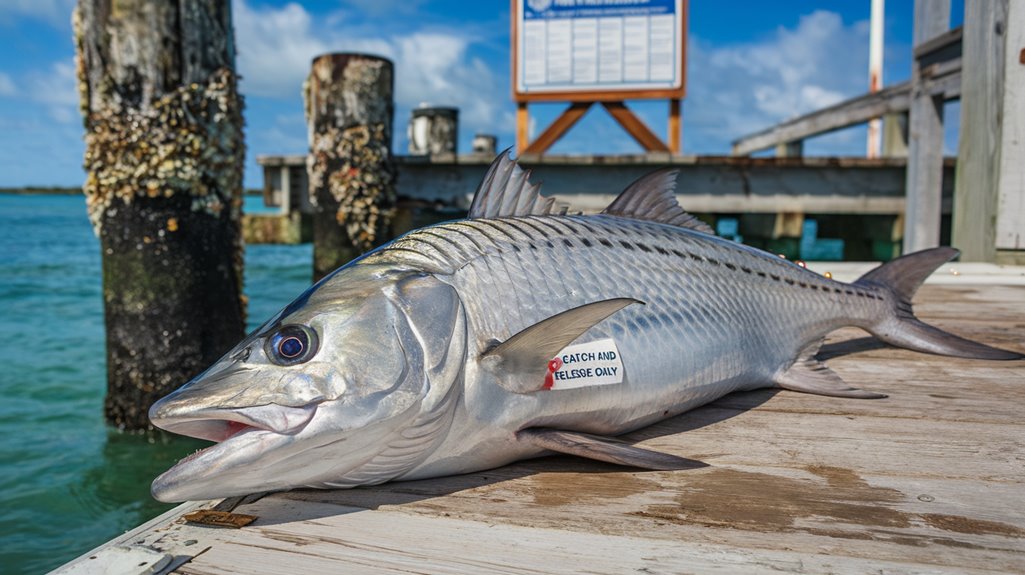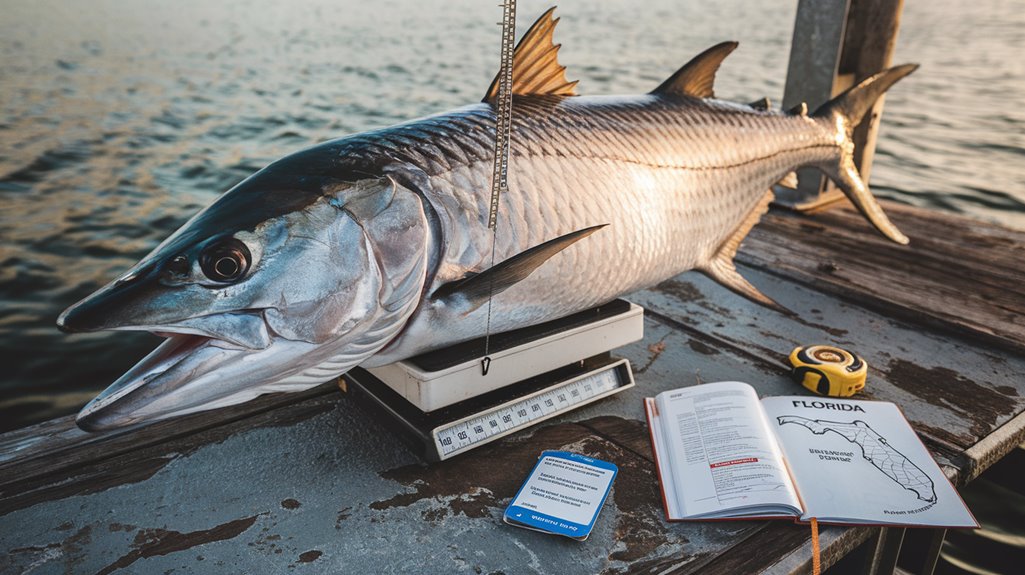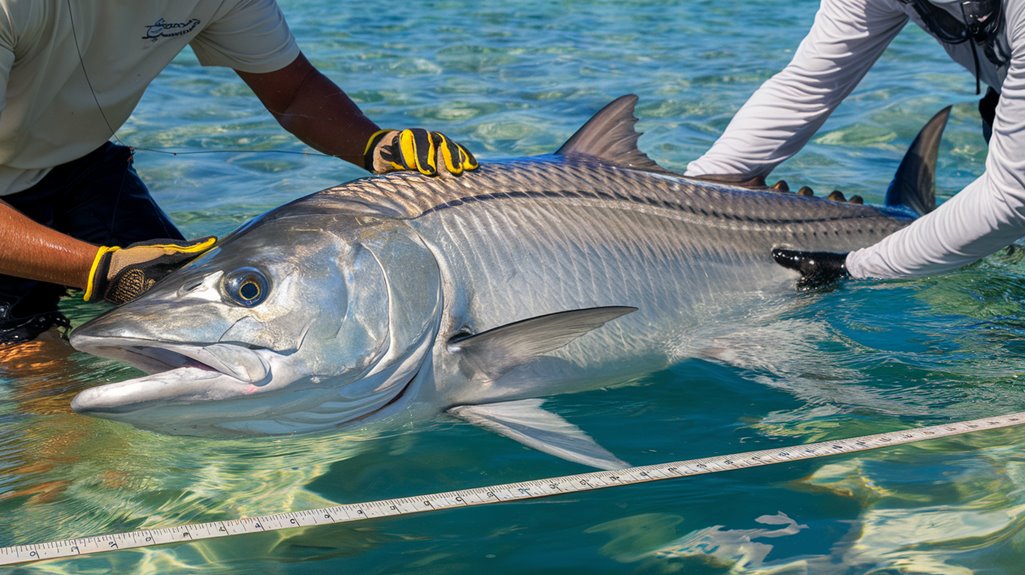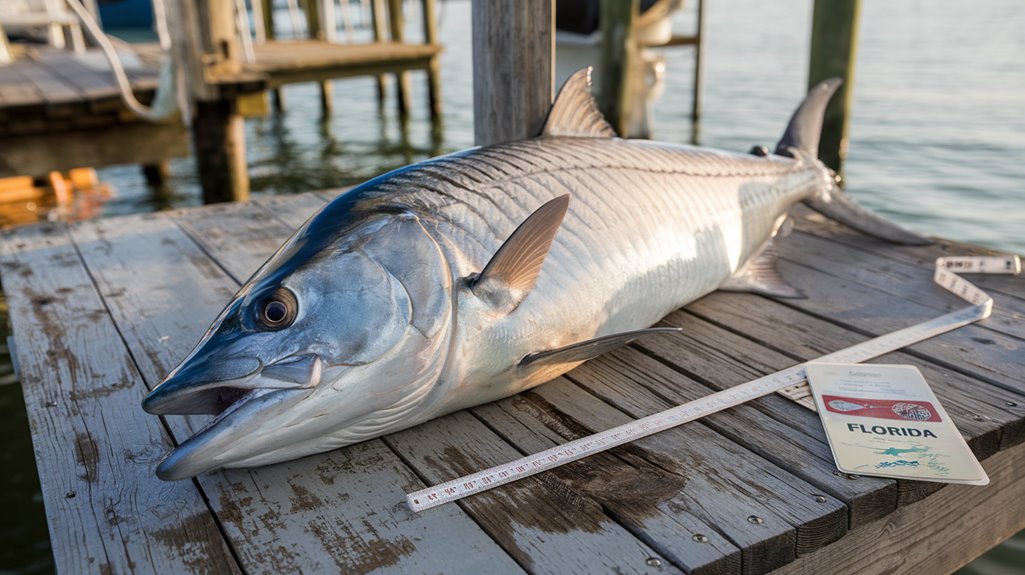You'll find that tarpon's status as a non-edible gamefish shapes Florida's strict fishing regulations. These remarkable silver-scaled giants, while prized for their spectacular aerial displays and fighting spirit, contain numerous small bones and emit an unpleasant odor that makes them unsuitable for consumption. Understanding the rules governing tarpon fishing isn't just about compliance – it's essential for preserving this iconic species that drives Florida's multi-million dollar recreational fishing industry.
- Key Takeaways
- The Non-Edible Nature of Tarpon Fish
- Florida's Catch-and-Release Requirements
- Essential Gear and Equipment Guidelines
- Boca Grande Pass Special Regulations
- Best Practices for Handling Tarpon
- Seasonal Considerations and Timing
- Cultural and Economic Significance
- Conservation Measures and Protection Status
- Frequently Asked Questions
- Conclusion
Key Takeaways
- Tarpon is not considered edible due to numerous small bones and an unpleasant odor that makes it unappetizing.
- Florida regulations explicitly prohibit the transportation and shipment of tarpon for consumption purposes.
- Tarpon must be released immediately, except for one tagged fish annually with proper permits from wildlife authorities.
- The fish is valued primarily for its recreational fishing qualities, generating approximately $300 million annually in tourism revenue.
- Tarpon over 40 inches must remain in water during catch, and proper handling techniques are required by law.
The Non-Edible Nature of Tarpon Fish

Though tarpon are prized gamefish, they're widely considered non-edible due to several significant factors. You'll find their flesh riddled with numerous small bones that are exceptionally difficult to clean and remove, making the preparation process impractical for most anglers. The fish also emits a strong, unpleasant odor that further diminishes its appeal as a food source.
In Florida, regulations explicitly prohibit the transportation and shipment of tarpon for consumption, reinforcing their non-edible status. Instead, these magnificent fish are primarily valued for their sporting qualities, with catch and release practices being the standard approach among anglers. Despite their impressive size, you won't find tarpon on menus or in fish markets, as their bony, unpalatable meat makes them unsuitable for consumption.
Florida's Catch-and-Release Requirements
If you're targeting tarpon in Florida, you'll need to follow strict catch-and-release regulations that prohibit harvesting these fish except with a special record-attempt tag. You must keep tarpon over 40 inches in the water during the entire catch process, and you're required to use non-stainless, non-offset, barbless circle hooks while avoiding methods like snagging or using multiple hooks with natural bait. The Florida Fish and Wildlife Conservation Commission emphasizes proper handling and quick release techniques to maximize the survival rate of caught tarpon.
Handling Large Tarpon Rules
Florida enforces strict regulations for handling large tarpon to protect these magnificent gamefish during catch-and-release encounters. If you're targeting tarpon over 40 inches, you must keep them in the water at all times. You'll need to handle smaller tarpon with wet hands to preserve their protective scales and minimize physical contact.
You can't drag tarpon across boat gunnels, rocks, or railings, as this causes severe injury to the fish. When photographing your catch, you'll need to work quickly to reduce the tarpon's time out of water. If your tarpon appears lethargic after the fight, you must revive it by allowing water to flow through its mouth and over its gills before release. These handling rules help guarantee Florida's tarpon population remains healthy for future anglers.
Release Techniques and Regulations
Strict catch-and-release regulations govern tarpon fishing in Florida's waters, requiring immediate release after capture with no daily bag limit. You're allowed one tarpon tag per year solely for pursuing record catches, but otherwise, these fish must be promptly returned to their habitat.
When practicing proper release techniques, you'll need to keep tarpon over 40 inches in the water at all times. Use non-stainless, non-offset, barbless circle hooks to minimize harm during capture. Handle smaller tarpon with wet hands, avoiding contact with boat surfaces. For successful revival, guarantee water flows through the fish's mouth and over its gills before release. If you're dealing with a lethargic tarpon, take time to properly revive it by maintaining this water flow until it shows signs of recovery.
Essential Gear and Equipment Guidelines

Successful tarpon fishing requires specific gear tailored to these powerful gamefish. You'll need to equip yourself with medium to extra heavy rods matched with 5,000 to 10,000 series reels, spooled with 50 to 60-pound braided line for peak performance. When fishing in Florida waters, you must use non-stainless, non-offset, barbless circle hooks for bait to comply with state regulations.
A fighting belt or chair provides essential support during extended battles, while a long-handled dehooking tool guarantees quick and safe hook removal to minimize stress on the fish. When fishing in Boca Grande Pass, you'll need to follow additional gear requirements, including keeping weights positioned above hooks and avoiding breakaway gear to maintain compliance with local regulations.
Boca Grande Pass Special Regulations
When fishing for tarpon in Boca Grande Pass, you'll need to confirm your gear configuration complies with the rule prohibiting weights that hang lower than the hook, and you must properly stow any non-compliant equipment. During peak tarpon season from April through June, you're restricted to using no more than three fishing lines per vessel, and breakaway gear is not permitted. Natural bait doesn't count as a weight under these regulations, but you must still follow the hook-and-line-only requirement, as other methods like snagging or spearing are strictly forbidden.
Gear Weight Restrictions
The Boca Grande Pass enforces specific gear weight restrictions to prevent tarpon snagging and protect the local fishery. When you're fishing in the Pass, you'll need to guarantee your weights don't hang below your hooks when the line is suspended. If you have non-compliant gear on your vessel, you must keep it properly stowed.
From April through June, you can't use any breakaway gear, as it poses a risk of illegal snagging. While natural dead bait isn't classified as a weight under these regulations, you should be aware that jigs with sliding weights on the shank aren't permitted. These gear weight restrictions are essential components of ongoing conservation efforts, helping maintain a sustainable tarpon population in the Pass while allowing for responsible fishing practices.
Line Limits During Spring
During Boca Grande Pass's prime tarpon season from April through June, you'll need to limit your vessel to three fishing lines in the water at any time. These Florida state regulations are specifically designed to protect tarpon during their critical spawning period while maintaining sustainable fishing practices.
When fishing in Boca Grande Pass during spring, you must adhere to these fundamental requirements:
- Keep your fishing lines limited to three per vessel
- Make certain all weights attached to hooks don't hang below the hook point
- Avoid using any breakaway gear, as it's strictly prohibited
- Stow any non-compliant gear properly if it's on board
These gear restrictions help minimize potential harm to tarpon populations while promoting responsible angling practices during the peak fishing season in this crucial spawning area.
Best Practices for Handling Tarpon

Proper handling techniques for tarpon are essential to guarantee their survival after catch and release. For tarpon over 40 inches, you'll need to keep them in the water at all times during handling to secure their safety. When dealing with smaller tarpon, wet your hands before touching them to protect their protective coating and scales.
Never drag tarpon across boat surfaces, rocks, or rails, as this can cause serious injury. Instead, maintain them in the water or utilize a landing net for safer handling. Keep a long-handled dehooking device ready to minimize stress and reduce handling time. If you're planning to photograph your catch, have your camera prepared beforehand to ensure a quick release, maximizing the tarpon's chances of survival.
Seasonal Considerations and Timing
When planning your tarpon fishing expedition, understanding seasonal patterns proves critical for success. Florida's tarpon season typically begins in late February, with peak activity occurring from April through June as water temperatures reach ideal levels. You'll need to take into account both timing and seasonal regulations for the most productive catch-and-release experience.
- Early season (February-March): Adult tarpon concentrate in South Florida's coastal waters
- Prime season (April-June): Fishing conditions reach their peak with warmer temperatures
- Night fishing: Enhanced success rates due to increased tarpon activity after dark
- Location shifts: Fish move between deeper waters and bridges depending on time of day
These seasonal patterns directly impact your fishing strategy, requiring you to adjust your approach based on water temperature, time of day, and location throughout the season.
Cultural and Economic Significance
The tarpon's cultural and economic impact on Florida's fishing industry extends far beyond its value as a food source, generating approximately $300 million in annual revenue through recreational fishing. As a premier Game Fish, the "Silver King" has become a cornerstone of Florida's sporting heritage, despite being unsuitable for consumption due to its bony structure and strong odor.
You'll find that the catch-and-release philosophy has emerged as both a conservation necessity and economic strategy. The FWC's protective regulations reflect lessons learned from Port Aransas, Texas, where the collapse of their tarpon fishery served as a stark warning. Local businesses and fishing communities now depend on sustainable practices to maintain tarpon populations, recognizing that their economic survival is intrinsically linked to the preservation of this iconic species.
Conservation Measures and Protection Status
Recognizing tarpon's vital role in Florida's economy, state wildlife authorities have implemented thorough protection measures to guarantee the species' long-term survival. The Florida Fish and Wildlife Conservation Commission's conservation measures prioritize the protection of these valuable fish through strict regulations and catch-and-release requirements.
- You're required to release all tarpon caught, except for one tagged fish per person annually for record attempts
- Any tarpon over 40 inches must remain in the water during tournaments
- The use of gear that could potentially snag or harm the fish is prohibited
- These protective measures support Florida's $300 million tarpon fishing industry
These regulations demonstrate how conservation efforts can balance environmental protection with recreational fishing interests, ensuring tarpon populations remain viable for future generations.
Frequently Asked Questions
Is It Legal to Eat Tarpon in Florida?
You can't legally harvest tarpon in Florida for food. You'll only get a permit to keep one if you're pursuing a state record, and it requires proper documentation.
Is There a Limit on Tarpon in Florida?
You can't keep tarpon in Florida as it's catch-and-release only. You're limited to one tarpon tag annually if pursuing records, and you must follow the three-line vessel restriction during peak season.
Is It Safe to Eat Fish From Lake Tarpon?
You'll need to check current health advisories before consuming fish from Lake Tarpon, as some species may contain contaminants. It's recommended to monitor local FWC guidelines for safe consumption levels.
Is It Safe to Feed Tarpon?
You shouldn't feed wild tarpon as it disrupts their natural feeding patterns and can make them dependent on humans. This practice is discouraged and may be restricted in some Florida locations.
Conclusion
While you'll find tarpon to be an exciting game fish, they're not suitable for consumption due to their bony structure and poor taste qualities. Florida's strict regulations require catch-and-release practices, specialized gear, and proper handling techniques. Your compliance with these measures supports the species' conservation and guarantees the sustainability of Florida's $1.1 billion recreational fishing industry, which relies heavily on tarpon as a premier sport fish.

